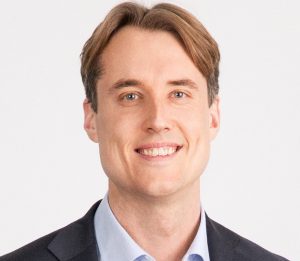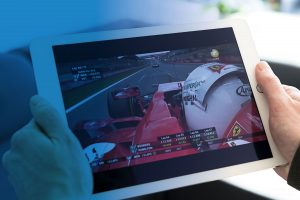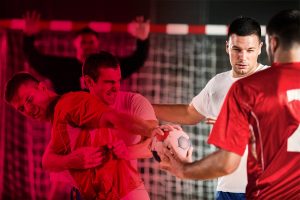SVG Europe Sit-Down: Net Insight’s Martin Karlsson discusses remote production and benefits of a live OTT streaming solution

Martin Karlsson, CTO & vice president product portfolio, Net Insight
Stockholm-based Net Insight predicted that the Internet was the future of television way back in 1997. This vision has guided the company’s progress for the past 20 years and has enabled it to provide a live and interactive media experience for broadcasters, service providers, content owners production and post production companies across the world.
By simplifying workflows and network complexities, Net Insight helps clients to improve the balance between content value and cost of production – opening up new opportunities for telecom, satellite, DTT, cable TV, IPTV and OTT operators. As CTO and vice president product portfolio, Martin Karlsson, explains, this also involves creating partnerships.
You recently announced a strategic partnership with Calrec Audio. Can you explain how this works?
Net Insight partnered with Calrec Audio to simplify the challenges broadcasters face when deploying remote live productions. Together we are offering an industry-leading remote production solution that integrates our media transport platform, Nimbra, with Calrec’s RP1 Remote Production unit. The result is simple connectivity, quality assured transport and precise control of audio mixes from any location.
This solution delivers many advantages. With fewer resources needed on site, broadcasters can now control audio from a remote console, saving money on setup time, crew, logistics and equipment. Production can be up and running quickly thanks to the plug-and-play unison of just two boxes. In addition, operation does not require high-level technical expertise, and assured no-latency audio processing from any venue to any production base is possible. In short, we are ensuring simple connectivity, quality assured transport and precise control of audio mixes from any location.
Beyond that arrangement, how do you see remote production expanding in the near-future?
Remote production is the future. It enables the delivery of more live content with better quality for less delivering a win-win for all parties. However, there are still barriers to widespread adoption, such as breaking down cultural and workflow perceptions within the industry.
Some examples are that the delay must be low to allow for a natural interaction and control; bandwidth efficiency is essential for the multiple camera feed transport, audio and video signals need to be in perfect sync when they enter the central production studio, and anxiety about the ability of technology to function if multiple expert technicians are not on site to monitor or solve an issue.
Net Insight is also in a partnership with Ericsson. What will this bring to the sports broadcasting industry?

Sye enables live content to be streamed with ultra-low delay and frame-accurate synchronisation across OTT devices
Net Insight is collaborating with Ericsson to offer broadcasters end-to-end video processing and workflow automation packages. We are combining our media switch routers and video appliances with Ericsson’s contribution codecs to deliver a managed end-to-end media contribution package for live media production. The partnership allows Net Insight to add Ericsson’s H.264 and HEVC (high-efficiency video coding) capabilities to its Nimbra portfolio. H.264 and HEVC are increasingly vital for delivery of live premium sports content over bandwidth constrained networks. We are unlocking the true potential of software defined media production as automation and orchestration of end-to-end media workflows offer real business value to the broadcast industry.
Can you explain more about the Sye live OTT solution, and how this benefits sports broadcasting?
Sye is the world’s first true live OTT streaming solution, enabling live content to be streamed with ultra-low delay and frame-accurate synchronisation across OTT devices. Sye delivers harmonisation between the OTT stream and the linear broadcast, enabling the OTT audience and traditional TV audiences to watch exactly the same content at exactly the same time.
Bridging the gap between these two audiences also solved the problem with the OTT audience being disconnected from social platforms during live events. Everyone can now share their live experiences and interact wherever they are, whatever platform they’re on, in real time. Furthermore, Sye is built around a resilient streaming protocol crafted from the ground up. It is optimised for live streaming, with minimum overhead and maximum network utilisation. Compared to traditional OTT streaming solutions Sye is not only faster but also more efficient.
How can OTT increase revenue streams for broadcasters?
Sye is a “game changer” and will impact social TV experiences, viewer behaviour and engagement by providing a higher QoE – Quality of Experience. This opens unprecedented revenue generating opportunities in live TV. Because Sye solves the issue of sync and delay, the first and second screens can become integrated, enabling second screens to serve as extensions of the viewing experience on the first screen. By giving the TV viewers a great multiscreen experience they become and remain more engaged.

TV2 in Denmark uses a Net Insight solution for handball coverage
This opens up significant business potential via enhanced viewer engagement and new advertisement models by adding value-added applications such as real-time social media commentary, interactive gaming, in-game betting, voting and polling – all within a real-time TV viewing experience.
By 2020, annual revenues from online and linear advertising are projected to exceed $266 billion. Our live OTT solution, Sye, can let broadcasters get a big piece of that pie. A large portion of this ad revenue resides on traditional broadcast platforms. As the number of viewers on OTT platforms grows, it becomes increasingly important to optimise the ad experience for the OTT audience. Sye includes a server-side ad insertion service created specifically for OTT platforms, giving a seamless TV experience with frame-accurate ad splicing. No more client buffering or spinning wheels.
Tell us about recent developments with your Internet Media Transport solutions?
With our Nimbra VA family of video appliances, we enable broadcasters and content owners to deliver more content by leveraging the reach of the Internet and other low-cost IP infrastructures, while also enabling Internet media transport as a backup to satellite transport. By combining MPEG4 and HEVC multichannel codecs along with integrated Internet transport, we provide a turn-key solution for Internet contribution in a one-box solution. With our virtual appliance, we enable migration to a hybrid cloud, as well as improving on the total cost of ownership. Our customers can reach content from a multitude of sources at a cost point that was previously unattainable. This opens a whole new market where niche and local content can be monetised.
Is there a European sports-related case study which illustrates how your solutions help broadcasters?
The task facing TV 2 Denmark was a desire to expand its coverage of the hugely popular live handball matches to meet the rise in demand, while at the same time reducing the overall cost of the production. Since live event production is resource-intensive, to effectively increase its output the broadcaster sought a solution that would address and eliminate bottlenecks in its live production workflows.
The most obvious way to streamline the cost of live event production is to reduce the burden of its most expensive resource — the facilities required to capture, process and produce at a venue and the engineers needed to set-up, operate and manage it.
TV 2 Denmark turned to Net Insight’s Nimbra as the solution to its live remote production infrastructure. The broadcaster wanted a ‘plug and play’ set-up that they could easily transport to any venue. This fly-away system, deployed in partnership with Net Insight partner Borch Teknik A/S, packs all the equipment into a single flight case and replaces the need for a dedicated OB van.
Five HD video feeds with JPEG2000 compression are sent from the sports arena back to TV2 Denmark’s central production hub at its headquarters in Odense. Along with the video, 28 embedded audio channels, as well as several VLANs to cover all necessary data for intercom, tally and TV 2 office intranet are carried over a 1Gb/s connection to the HQ with two SD uncompressed video feeds routed from the HQ in return.
Each production requires just nine staff to be located on-site – five camera operators, one audio and one video technician, a commentator and a presenter. The five camera operators cover the match production as well as pre- and post-show interviews with all other traditional OB operations managed centrally. This means that the scarce and highly specialised production staff is used centrally, possibly covering multiple events per day.

